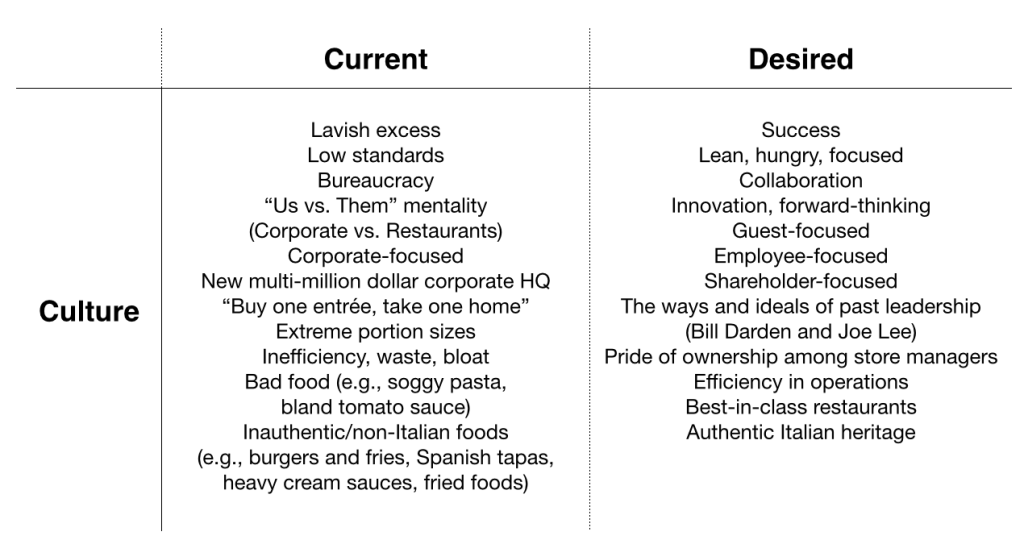 Tasteless, hotdog-bun-like bread sticks. Bland pasta sauce. Operational inefficiency. Excessive corporate spending on private jets and a crappy new logo. These are just a few of the issues identified with the casual dining chain Olive Garden in a scathing September 2014 report entitled “Transforming Darden Restaurants.”
Tasteless, hotdog-bun-like bread sticks. Bland pasta sauce. Operational inefficiency. Excessive corporate spending on private jets and a crappy new logo. These are just a few of the issues identified with the casual dining chain Olive Garden in a scathing September 2014 report entitled “Transforming Darden Restaurants.”
The 294-page report was written by Starboard Value*, an investment firm representing Darden/Olive Garden shareholders. A decline in profits has caused the firm to demand some serious change at both the corporate and storefront level to increase sales and keep shareholders satisfied. It presents a 14-point “turnaround plan” based on what it thinks are the key causes of the decline, and calls for the resignation of all executive board members, who the firm sees as the root cause of the chain’s poor performance.
Conceptualizing Organizational Culture
While Starboard Value sees a change in leadership as the first step to success, another top priority is to “fix” Olive Garden’s “culture.” As Microsoft researcher Sam Ladner notes in her book “Practical Ethnography: A Guide to Doing Ethnography in the Private Sector,” “The word “culture” gets thrown around a lot in business today. Often people talk about “culture,” but they rarely spell out what it means…they never define what culture actually is or how one can understand it, much less measure it” (2014: 34). In fact, the word “culture” is mentioned 28 times in the Starboard Value report, so it’s clearly something they think is important. Yet, how is Starboard Value conceptualizing “culture” in the case of Olive Garden? To start, there’s no definition of culture to be found (not to mention a framework for thinking about past/current/future culture), so the reader is left to infer its meaning through the various examples of good and bad behavior that are highlighted. It’s an an abstract thing that is described as “fixable,” in that it is currently broken, and as something to be brought back from/modeled on the past, in that it is no longer what it used to be. A successful and ideal “past/future culture” is juxtaposed with the harmful “current culture” that has led the company astray and caused sales to decline. If anything, the authors are certain that the new culture should be strong, innovative, empowering, focused on people, and driven by a reverence for the pride and efficiency of the past espoused by previous leadership.
Here are some direct quotes that illustrate how culture is discussed in the report:
- “Darden is in dire need of change…we believe new people, new energy, and a new culture will improve the business.”
- “Fixing the culture so employees are once again excited to serve guests”
- “As Joe Lee emphasized, running a successful restaurant concept is about the people. The leadership at the top of the company (especially the CEO) must inspire a strong culture and demonstrate a desire to lead superb operations.”
- “A return to Darden’s past culture to promote a lean, hungry and focused management team that holds shareholder value creation in high regards. The current culture promotes lavish excess, bureaucracy, and low standards.”
- “With the right leaders in place and with a culture of innovation, we believe Olive Garden will be successful.”
- “Darden’s employee base is its greatest asset. We plan on improving the focus and culture of the organization to empower the people and drive success.”
- “Many of the innovations and improvements Mr. Blum and Mr. Mock made when they ran Olive Garden have been lost in the past 10 years. We want to bring back Olive Garden’s best-in-class, guest-first focus and culture of success, all while modernizing the concept to address today’s consumer needs…”
In a nutshell, the current culture is associated with anything that’s “wrong” or “bad” or that leads to lower sales; the desired culture is anything that can be described as generally good for a business and the opposite of the status quo.
 “Fixing the Culture” of an Organization
“Fixing the Culture” of an Organization
How do you go about “fixing” the culture of an organization without a definition of culture in which to ground change? Likewise, is culture a problem that can be fixed? From the looks of the report, Starboard Value put a lot of effort into thinking about areas of opportunity and corresponding recommendations, at least from a business and finance perspective. Leadership, products and marketing are all important elements of running a business, along with an organization’s driving philosophies and values. Making changes that include revising the menu, replacing executives, and cutting costs to increase efficiency and profits may indeed be helpful. They’re off to a decent start.
Yet, the authors of the report are the kind of people you would typically find at an investment firm – guys with training in business, finance and economics, not the social sciences. They are probably pretty good at pointing out issues related to money, operations and efficiency, and making recommendations based on “best” financial practices. But they don’t bring a cultural perspective to their analysis, so how far can their concept of the “culture” of Olive Garden really go?
Starboard Value plans to bring on an “all-star cast” of “restaurant operators, turnaround specialists, real estate experts and corporate governance veterans” to help with the change effort. Great! But to really understand the Olive Garden culture, the change process, and the efficacy of changes, what if they (or Darden Restaurants who whoever ends up leading the effort) brought an anthropologist on board to complement these other perspectives? I’m thinking of business anthropology consultants like Grant McCracken or Amy Goldmacher or MaryAnn McCabe or Pedro Oliveira, or firms like Cultural Keys or Practica Group whose practices are based in an anthropological approach.
By employing a sociocultural lens that incorporates both insider and outsider perspectives, anthropologists could help lead an exploration of the organization as a cultural entity to fully understand what’s happening. They could more fully define what the current culture is and what it could and should be, and make recommendations based in social science research to complement (or validate or refute) the recommendations from business perspective that are based in economic models and processes. They could identify issues and make suggestions for resolving them, and figure out which ones are more or less pressing. They could participate in and manage the change process, and measure its progress and outcomes.
Most importantly, an anthropologist would not describe culture as something you can force change upon simply by telling people they need to change it or simply by replacing elements of it without implementing other measures for sustainability. It’s a deliberate and slow process of evolution that can be driven in part by leadership but must also be inclusive and have the buy-in of everyone at all levels, from executives to management to servers and cooks.
In the end, what Starboard Value thinks it knows about the culture of Olive Garden might contrast greatly with the results of what an anthropologist would find through systematic observation, participation and real cultural analysis, all wrapped up in a nice theoretical framework that explains what’s going on rather than simply describing it. An anthropological approach would consider the organizational culture in a holistic, contexual manner (employees, structures, systems, products, brand, marketing, external factors and customer experience). It would view culture as something to be understood, not as a problem. Such an approach would likely provide delightfully surprising and helpful results to strengthen the recommendations of a multidisciplinary team.
Notes:
*Starboard Value’s name is as bad as its website and all-male staff.
Always a pleasurable read: Marilyn Hagerty’s review of the Olive Garden in Grand Forks, Michigan.
Thanks to Steve Portigal for bringing the Starboard Value report to my attention.
Check out this guy’s blog documenting his use of the Olive Garden Never Ending Pasta Pass.
Olive Garden photo by Mike Mozart.

Great piece you could send to Olive Garden (along with a resume and proposal).
This definitely a job for a consumer / business anthropologist. I do a lot of work for companies like this that usually involves taking a look at the out issue world and at their customer’s cultural context but so rarely do corporations take the time to look at business issues from the inside out and do the work to understand not just the culture of their organization – bit the sociological factors keeping their organization from growth or even contributing to business failure.
My “business” brand / company is The Brand Sherpa. 😉
Reblogged this on The Narcissistic Anthropologist and commented:
A classic dilemma that so few corporations ever actually take the time to scope and solve. But there is an anthropologically-based solution possible here—starts with remembering that companies are made up of…wait for it….HUMANS!!!
I got a gift card to Olive Garden a while ago, and I when I there I kept thinking about what they needed to do to refresh the brand/food/and like everything. I actually like the new logo? Or at least think it’s an improvement. It’s everything else that needs to be redone.
I like your logo too, Anthropologizing.
Thanks! My header is by Jenny Ambrose at http://www.pureefantastico.com in case you are interested.
Gorgeous! Im actually a graphic designer, just admiring the work. Great solution.